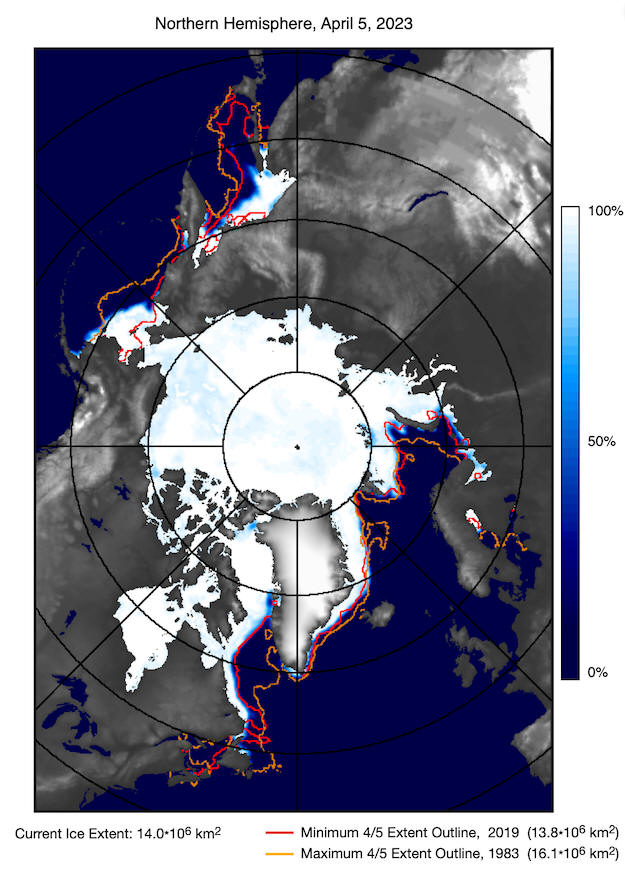
|
||||||||||||
|
|
Arctic Sea Ice
Most Arctic sea ice occupies an ocean basin largely enclosed by land. Because there is no landmass at the North Pole, sea ice extends all the way to the pole, making the ice subject to the most extreme oscillations between wintertime darkness and summertime sunlight. Likewise, because the ocean basin is surrounded by land, ice has less freedom of movement to drift into lower latitudes and melt. Sea ice also forms in areas south of the Arctic Ocean in winter, including the Sea of Okhotsk, the Bering Sea, Baffin Bay, Hudson Bay, the Greenland Sea, and the Labrador Sea.
What is sea ice?Sea ice is frozen ocean water. It forms, grows, and melts in the ocean. In contrast, icebergs, glaciers, and ice shelves float in the ocean but originate on land. For most of the year, sea ice is typically covered with snow. Why is Arctic sea ice important?Arctic sea ice keeps the polar regions cool and helps moderate global climate. Sea ice has a bright surface; 80 percent of the sunlight that strikes it is reflected back into space. As sea ice melts in the summer, it exposes the dark ocean surface. Instead of reflecting 80 percent of the sunlight, the ocean absorbs 90 percent of the sunlight. The oceans heat up, and Arctic temperatures rise further. A small temperature increase at the poles leads to still greater warming over time, making the poles the most sensitive regions to climate change on Earth. According to scientific measurements, both the thickness and extent of summer sea ice in the Arctic have shown a dramatic decline over the past thirty years. This is consistent with observations of a warming Arctic. The loss of sea ice also has the potential to accelerate global warming trends and to change climate patterns. What is sea ice extent, and why do you monitor that particular aspect of sea ice?Sea ice extent is a measurement of
the area of ocean where there is at least some sea ice. Usually,
scientists define a threshold of minimum concentration to mark the ice
edge; the most common cutoff is at 15 percent. Scientists use the 15
percent cutoff because it provides the most consistent agreement between
satellite and ground observations. What is the Arctic sea ice minimum?The Arctic sea ice minimum marks the
day, each year, when the sea ice extent is at its lowest. The sea ice
minimum occurs at the end of the summer melting season. What is the Arctic sea ice maximum?The Arctic sea ice maximum marks the
day of the year when Arctic sea ice reaches its largest extent. The sea
ice maximum occurs at the end of the winter cold season. Impacts of Arctic Sea Ice LossProjected effects of declining sea ice include loss of habitat for seals and polar bears, as well as movement of polar bears onto land where bear-human encounters may increase. Indigenous peoples in the Arctic who rely on Arctic animals for food have already described changes in the health and numbers of polar bears. As sea ice retreats from coastlines, wind-driven waves—combined with permafrost thaw—can lead to rapid coastal erosion. Alaskan and Siberian coastlines have already experienced coastal erosion. Other potential impacts of Arctic sea ice loss include changed weather patterns: less precipitation in the American West, a weaker storm track that has shifted south over the Atlantic, or (according to one simulation) an intensified storm track. Some researchers have hypothesized that melting sea ice could interfere with ocean circulation. In the Arctic, ocean circulation is driven by the sinking of dense, salty water. A cap of freshwater resulting from rapid, extensive sea ice melt could interfere with ocean circulation at high latitudes. Although a study published in 2005 suggested that the Atlantic meridional (north-south) overturning circulation had slowed by about 30 percent between 1957 and 2004, that conclusion was not based on comprehensive measurements. Subsequent modeling analyses indicated that the freshwater from melting sea ice was not likely to affect ocean circulation for decades.
,NSIDC |



